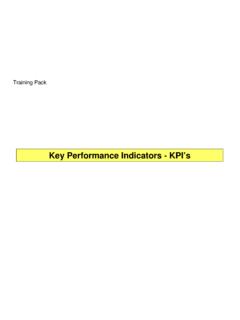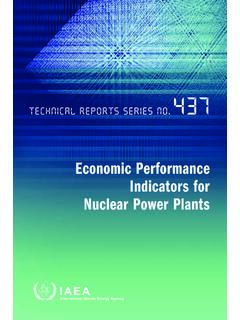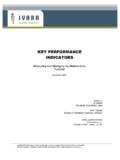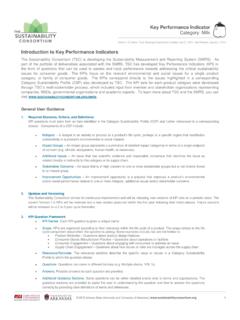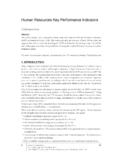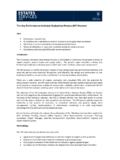Transcription of Key Performance Indicators for the CCS - EII
1 1 EUROPEAN COMMISSION DIRECTORATE-GENERAL JOINT RESEARCH CENTRE Institute for Energy SET-Plan Information System (SETIS) Key Performance Indicators for the CCS - EII Background In March 2010, Member States adopted conclusions1 on the Strategic Energy Technology Plan (SET-Plan) on the basis of the Commission Communication "Investing in the Development of Low Carbon Technologies" [COM(2009) 519 final]. These included the launch of the six EIIs2 of the SET-Plan by 2011 and called for the establishment of a common set of principles and practices for their implementation, which include the development and systematic use of key Performance Indicators (KPIs). In the same meeting the Council requested the Commission to develop to its full capacity the SET-Plan Information System (SETIS) in order to provide a robust technology-neutral planning tool.
2 SETIS was engaged in all EII Teams to contribute to the identification and quantification of KPIs, which were subsequently incorporated in the Implementation Plans for 2010-2012. KPIs represent an essential toolkit for monitoring and reviewing the overall progress of the CCS-EII, and of the individual research, development and demonstration (RDD) activities performed in frame of its implementation. KPIs will become instrumental for planning RDD activities, funded under the current and the upcoming R&D framework programmes and other possible funding schemes (such as NER 300), aiming to support the CCS-EII. More specifically, projects supporting the implementation of the CCS-EII, will need to demonstrate the link between their objectives and the KPIs of the CCS-EII they will be contributing to.
3 As such, these projects will be integrated into the Monitoring and Review Framework of the SET-Plan. The practicalities of this exercise and the modus operandi, and particularly with reference to the later stage of analysis of the data and their feeding into the technology-neutral planning tool of SETIS, are still to be defined. The CCS-EII Team, under the guidance of SETIS3, developed a set of KPIs, which was incorporated in the Implementation Plan 2010-2012. Taking into consideration the fact that KPIs may need to be modified in the future to adapt to the continuous industrial and technological progress of the sector, the KPIs of the Implementation Plan 2010-2012 have been further refined in order to focus on ongoing and future RDD activities related to prioritized actions of the Implementation Plan of the EII.
4 These KPIs form the first 1 3001st Transport, Telecommunications and Energy Council meeting of 12th March 2010. 2 The European wind initiative, the solar Europe initiative, the European electricity grid initiative, the sustainable bio-energy Europe initiative, the European CO2 capture, transport and storage initiative, the sustainable nuclear fission initiative and the initiative on fuel cells and hydrogen. 3 The Council has requested the Information System of the SET-Plan (SETIS) to assess Performance and cost-effectiveness and to monitor the progress of the SET Plan activities towards their objectives in a transparent and objective way. 2 generation of the CCS-EII KPIs4and pave the way to the constitution of the first Monitoring and Review Framework for the CCS-EII.
5 To this end, it is noted that the implementation of planning, monitoring and progress review based on KPIs also requires, first of all access to relevant and reliable data, the setup of data collection/monitoring, review and feedback procedures and the establishment of a knowledge sharing process. These procedures will be elaborated and described in detail by the CCS-EII Team in the course of 2011. In this process, the CCS EII Team will take stock specifically of the work that has already been performed so far in the context of the European CCS Demonstration Project Network (PN)5, funded by the EU. It is noted that the PN is composed of European demonstration projects that are at a sufficient scale and level of maturity that will generate valuable output and knowledge about the industrial-scale CCS demonstration.
6 Its already developed knowledge sharing protocol listing the information to be shared regularly within and beyond the Network membership, and describing the implementation logic of such a sharing process, will be a solid base for the CCS EII data gathering and monitoring process. General Principles The KPIs for the CCS-EII have been developed based on the following principles: KPIs are defined in a straightforward format (formulas and basic assumptions are provided) so that they can be easily understood (and hence accurately and unambiguously measured and subsequently interpreted) by the EII-Team, programme/project managers and policy makers. Overarching KPIs are used to measure the progress of the CCS-EII towards meeting its strategic objectives, namely the improvement of the cost competitiveness of the technology and its further development to allow its application in all carbon intensive industrial sectors.
7 2nd tier KPIs are used to measure progress at the project level. They will be utilized to gauge progress towards the overarching KPIs of the CCS demonstration programme and where feasible of other RDD projects, funded by FP7 and any other funding instrument. To this end, continuity between the overarching KPIs and 2nd tier KPIs is ensured where there is an apparent link. KPIs targets are set for critical EII milestones for 2020 and 2015. However the overarching KPIs will only be calculated for large commercial power plants with start of operation in early 2020s. The 2nd tier KPIs at demo project level will be scaled up to large commercial size correspondingly. The current understanding of KPI values is used to define a baseline and reference point for assessing technological improvements achieved by the contributing projects.
8 Significant work on the definition and quantification of the KPIs has already been done, in particular, by the CCS Demonstration Project Network and ZEP (Zero Emissions Platform) ETP (European Technology Platform). Thus, this document draws heavily from the newly published reports by ZEP ETP on the costs of CO2 capture6, transport7 and storage8 and the information and experience gathering form of the Project Network9. 4 KPIs for the remaining actions will be addressed at a later stage. 5 6 Add reference 7 Add reference 3 Transport and storage costs are excluded from the calculations of the overarching KPIs. Reason for this is that this cost is not primarily depending on technology development. In the dedicated ZEP cost report, cost of storage has been recognized to be very case dependent ( onshore versus offshore, size, characteristics and complexity of the geology, unknown aquifer or well described mature hydrocarbon ), and characterized by a large variability (from a few euros per tonne of CO2 to 20 /tCO2).
9 In the absence so far of cost data acquired under representative operating conditions, this cost has been excluded from the Levelised Cost of Electricity calculations. Also the transport costs are very much depending on location, on availability of existing structures, of utilization and if pipelines and terminals are designed for a system or for a single plant. Thus the transport and storage costs but will be considered as soon as demo projects have delivered more precise cost estimates and have identified strategies to reduce these costs. All costs thus represent the cost at the fence of the plant. The development of Transport and Storage of CO2 has to be monitored by other means than described in this memo, which has to be defined at a later stage.
10 Overarching KPIs The two overarching KPIs of the CCS-EII, which will be used for the monitoring and review of progress of the whole EII are: Levelised cost of electricity (LCoE), measured in /MWh Cost per tonne of CO2 avoided, measured in /tCO2 It is noted however, that LCoE is a KPI tailored to the needs of projects linked with the application of CCS in the power sector. A variant of this overarching KPI will be used for projects focused on CCS in industrial applications, such as in the cement, iron and steel or pulp and paper industries: Levelised cost of industrial product (LCoP), measured in /product unit10 (to be defined after the successful selection of relevant RDD projects). The overarching KPIs is calculated for the following cases: o Large commercial hard coal plant without CCS (Reference coal plant) o Large commercial hard coal plant with CCS o Large commercial natural gas (NG) plant without CCS (Reference NG plant) o Large commercial NG plant with CCS o Large commercial industrial plant without CCS (Reference industrial plant to be defined as soon as relevant RDD projects emerge) o Large commercial industrial plant with CCS (to be defined as soon as relevant RDD projects emerge) The Overarching KPIs for large commercial plants with CCS will represent average values reflecting the different capture technologies (post- and pre-combustion and oxyfuel).



